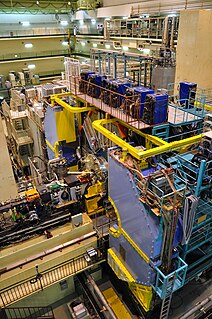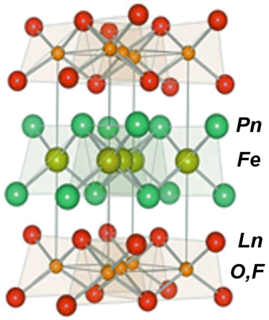Related Research Articles

A tetraquark, in particle physics, is an exotic meson composed of four valence quarks. A tetraquark state has long been suspected to be allowed by quantum chromodynamics, the modern theory of strong interactions. A tetraquark state is an example of an exotic hadron which lies outside the conventional quark model classification.

Geant4 is a platform for "the simulation of the passage of particles through matter" using Monte Carlo methods. It is the successor of the GEANT series of software toolkits developed by The Geant4 collaboration, and the first to use object oriented programming. Its development, maintenance and user support are taken care by the international Geant4 Collaboration. Application areas include high energy physics and nuclear experiments, medical, accelerator and space physics studies. The software is used by a number of research projects around the world.

MAGIC is a system of two Imaging Atmospheric Cherenkov telescopes situated at the Roque de los Muchachos Observatory on La Palma, one of the Canary Islands, at about 2200 m above sea level. MAGIC detects particle showers released by gamma rays, using the Cherenkov radiation, i.e., faint light radiated by the charged particles in the showers. With a diameter of 17 meters for the reflecting surface, it was the largest in the world before the construction of H.E.S.S. II.

The Compact Linear Collider (CLIC) is a concept for a future linear particle accelerator that aims to explore the next energy frontier. CLIC would collide electrons with positrons and is currently the only mature option for a multi-TeV linear collider. The accelerator would be between 11 and 50 km long, more than ten times longer than the existing Stanford Linear Accelerator (SLAC) in California, USA. CLIC is proposed to be built at CERN, across the border between France and Switzerland near Geneva, with first beams starting by the time the Large Hadron Collider (LHC) has finished operations around 2035.

In nuclear physics, an atomic nucleus is called a halo nucleus or is said to have a nuclear halo when it has a core nucleus surrounded by a "halo" of orbiting protons or neutrons, which makes the radius of the nucleus appreciably larger than that predicted by the liquid drop model. Halo nuclei form at the extreme edges of the table of nuclides — the neutron drip line and proton drip line — and have short half-lives, measured in milliseconds. These nuclei are studied shortly after their formation in an ion beam.

The Belle experiment was a particle physics experiment conducted by the Belle Collaboration, an international collaboration of more than 400 physicists and engineers, at the High Energy Accelerator Research Organisation (KEK) in Tsukuba, Ibaraki Prefecture, Japan. The experiment ran from 1999 to 2010.
In physics, the Tsallis entropy is a generalization of the standard Boltzmann–Gibbs entropy.

Boron arsenide is a chemical compound involving boron and arsenic, usually with a chemical formula BAs. Other boron arsenide compounds are known, such as the subarsenide B12As2. Chemical synthesis of cubic BAs is very challenging and its single crystal forms usually have defects.
In particle physics and string theory (M-theory), the ADD model, also known as the model with large extra dimensions (LED), is a model framework that attempts to solve the hierarchy problem. The model tries to explain this problem by postulating that our universe, with its four dimensions, exists on a so called membrane floating in 11-dimensional space. It is then suggested that the other forces of nature operate within this membrane and its four dimensions, while gravity can operate across all 11 dimensions. This would explain why gravity is very weak compared to the other fundamental forces. This is a radical theory given that the other 7 dimensions, which we do not observe, previously have been assumed to be very small, while this theory asserts that they might be very large.

Iron-based superconductors (FeSC) are iron-containing chemical compounds whose superconducting properties were discovered in 2006. In 2008, led by recently discovered iron pnictide compounds, they were in the first stages of experimentation and implementation..
CASTOR is an electromagnetic (EM) and hadronic (HAD) calorimeter of the CMS experiment at CERN. It is based on plates made out of tungsten and quartz layers, positioned around the beam pipe in the very forward region of the CMS, covering the pseudorapidity range 5.1 — 6.55. It is used in collider physics, proton-proton collisions and heavy ion collisions, for example lead collisions. It is designed to search for strangelets and centauro events, kinds of exotic matter in the baryon dense, very forward phase region in lead (Pb) collisions at the particle accelerator LHC, CERN near Geneva.
Bismuth selenide (Bi2Se3) is a gray compound of bismuth and selenium also known as bismuth(III) selenide. It is a semiconductor and a thermoelectric material. In its pure state it has a topological insulator ground-state. While perfect stoichiometric bismuth selenide should be a semiconductor (with a gap of 0.3 eV) naturally occurring selenium vacancies act as electron donors and it often acts as a semimetal in its as grown phase. Topologically protected Dirac cone surface states have been observed in Bismuth selenide and its insulating derivatives leading to intrinsic topological insulators, which later became the subject of world-wide scientific research.
The Zc(3900) is a hadron, a type of subatomic particle made of quarks, believed to be the first tetraquark that has been observed experimentally. The discovery was made in 2013 by two independent research groups: one using the BES III detector at the Chinese Beijing Electron Positron Collider, the other being part of the Belle experiment group at the Japanese KEK particle physics laboratory.

Kim Sun-kee is a South Korean physicist. He is professor in Seoul National University and director of the Korea Invisible Mass Search. He was the first director of the Rare Isotope Science Project within the Institute for Basic Science and is a member of the Korean Academy of Science and Technology.
Terence Richard Wyatt FRS is a Professor in the School of Physics and Astronomy at the University of Manchester, UK.

The China Jinping Underground Laboratory is a deep underground laboratory in the Jinping Mountains of Sichuan, China. The cosmic ray rate in the laboratory is under 0.2 muons/m²/day, placing the lab at a depth of 6720 m.w.e. and making it the best-shielded underground laboratory in the world. The actual depth of the laboratory is 2,400 m (7,900 ft), yet there is horizontal access so equipment may be brought in by truck.
The Dark Matter Particle Explorer, or DAMPE, is a Chinese Academy of Sciences (CAS) satellite which launched on 17 December 2015. The satellite was launched on a Long March 2D rocket from Launch Pad 603 at the LC-43 complex, also known as the South Launch Site, at the Jiuquan Satellite Launch Center. It is China's first ever space observatory.

The Beijing Spectrometer III is a particle physics experiment at the Beijing Electron–Positron Collider II at the Institute of High Energy Physics (IHEP). It is designed to study the physics of charm, charmonium, and light hadron decays. It also performs studies of the tau lepton, tests of QCD, and searches for physics beyond the Standard Model. The experiment started collecting data in the summer of 2008.
The term Dirac matter refers to a class of condensed matter systems which can be effectively described by the Dirac equation. Even though the Dirac equation itself was formulated for fermions, the quasi-particles present within Dirac matter can be of any statistics. As a consequence, Dirac matter can be distinguished in fermionic, bosonic or anyonic Dirac matter. Prominent examples of Dirac matter are Graphene, topological insulators, Dirac semimetals, Weyl semimetals, various high-temperature superconductors with -wave pairing and liquid Helium-3. The effective theory of such systems is classified by a specific choice of the Dirac mass, the Dirac velocity, the Dirac matrices and the space-time curvature. The universal treatment of the class of Dirac matter in terms of an effective theory leads to a common features with respect to the density of states, the heat capacity and impurity scattering.
References
- ↑ "ATLAS Detector". 2015-09-08.
- ↑ "CMS Detector".
- ↑ Asner, D. M; Barnes, T; Bian, J. M; Bigi, I. I; Brambilla, N; Boyko, I. R; Bytev, V; Chao, K. T; Charles, J; Chen, H. X; Chen, J. C; Chen, Y; Chen, Y. Q; Cheng, H. Y; Dedovich, D; Descotes-Genon, S; Fu, C. D; Tormo, X. Garcia i; Gao, Y. -N; He, K. L; He, Z. G; Hu, J. F; Hu, H. M; Huang, B; Jia, Y; Jin, H. -Y; Jin, S; Kuang, Y. P; Lacker, H; et al. (2008). "Physics at BES-III". International Journal of Modern Physics A. A24 (1). arXiv: 0809.1869 . Bibcode:2008arXiv0809.1869A.